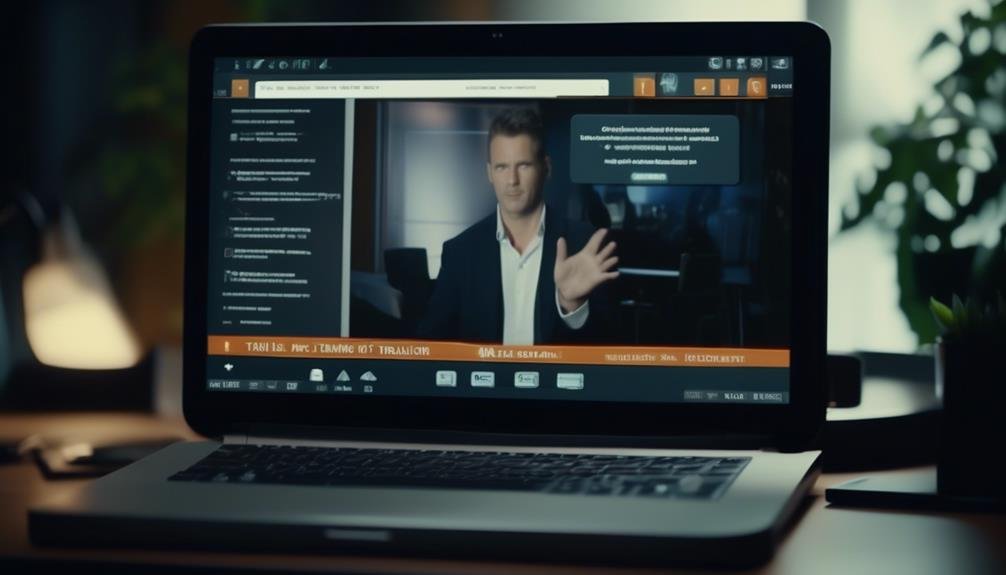Training Solution Demos: Seeing Is Believing in E-Learning
In the ever-evolving landscape of e-learning, the importance of training solution demos cannot be overstated. These demos not only provide a glimpse into the capabilities of various e-learning platforms but also offer a firsthand experience of their functionality.
As organizations continue to embrace e-learning as a cornerstone of their training strategies, the ability to witness the effectiveness of these solutions firsthand becomes increasingly vital. From personalized learning paths to interactive tools, the potential benefits are extensive.
However, the process of evaluating and selecting the right e-learning platform can be complex, making the role of training solution demos in facilitating informed decisions all the more crucial.
Key Takeaways
- Training solution demos enhance learning and retention for participants.
- Interactive learning tools, such as gamified assessments and virtual reality simulations, improve engagement and skill retention.
- Personalized learning paths cater to individual needs and preferences, preventing boredom or frustration.
- Compatibility testing ensures accessible and consistent user experience across devices and operating systems.
Importance of Training Solution Demos
Demonstrating the importance of training solution demos lies in their ability to provide a hands-on, interactive experience that enhances learning and retention for participants. One of the significant advantages of training solution demos is the ability to cater to visual learners. Visual learning is a dominant style for many individuals, and training solution demos offer an engaging way to present information.
Through visual aids, such as graphics, videos, and interactive modules, participants can absorb and retain information more effectively. This method allows for complex concepts to be broken down into easily digestible visual representations, making the learning process more accessible and enjoyable.
Additionally, training solution demos offer the advantage of real-time application. Participants can observe the practical implementation of concepts, processes, and procedures, which enhances their understanding and skill development. This hands-on approach fosters active participation and encourages a deeper level of comprehension.
Furthermore, the interactive nature of demos allows participants to engage with the material, reinforcing their learning through active involvement.
Key Benefits for Organizations
An organization can leverage the engaging and interactive nature of training solution demos to foster a culture of continuous learning and skill development among its employees. By incorporating e-learning training solution demos, organizations can reap a multitude of benefits, ranging from improved user experience to making informed decisions based on personalized learning paths. The table below outlines the key benefits for organizations when utilizing training solution demos in e-learning.
| Benefits | Description |
|---|---|
| Improved User Experience | Interactive tools and multimedia elements create an engaging learning environment. |
| Personalized Learning Paths | Employees can follow personalized learning paths based on their individual needs and preferences. |
| Platform Compatibility | Training solution demos are compatible with various devices and operating systems, ensuring accessibility for all employees. |
| Informed Decisions | Allows organizations to make informed decisions about the most effective e-learning best practices. |
These benefits not only enhance the learning experience but also contribute to the overall success and growth of the organization.
Enhanced User Experience
Enhancing the user experience plays a pivotal role in optimizing the effectiveness of e-learning training solution demos within organizational settings. A well-crafted user experience can lead to improved engagement and better learning outcomes.
Here's how enhanced user experience contributes to the success of e-learning training solution demos:
- Intuitive Navigation: A user-friendly interface with intuitive navigation features such as clear menu structures, interactive buttons, and progress tracking ensures that learners can easily access and move through the training content. This reduces frustration and allows them to focus on the learning material.
- Interactive Elements: Incorporating interactive elements, such as quizzes, simulations, and multimedia content, enhances user engagement. These interactive features not only make the learning process more enjoyable but also reinforce knowledge retention.
A user-centric design that prioritizes ease of use and interactivity can significantly impact the overall effectiveness of e-learning training solution demos. By creating an environment where learners can navigate seamlessly and engage with the content, organizations can maximize the benefits of their training programs.
Interactive Learning Tools
Pivotal to the creation of an immersive and effective e-learning training environment, interactive learning tools offer a dynamic approach to engaging learners and reinforcing knowledge retention. These tools are designed to enhance the learning experience by incorporating gamification benefits and virtual reality immersion, thereby significantly boosting engagement levels and skill retention. Utilizing interactive learning tools can transform traditional training into an interactive and engaging experience that resonates with modern learners.
| Interactive Learning Tools | Benefits | Examples |
|---|---|---|
| Gamified Assessments | Increases engagement levels | Quizzes with rewards |
| Virtual Reality Simulations | Enhances skill retention | VR training modules |
| Interactive Videos | Improves content retention | Branching video paths |
| Interactive Infographics | Simplifies complex concepts | Interactive data maps |
| Gamified Learning Platforms | Fosters healthy competition | Leaderboards, badges |
Personalized Learning Paths
Personalized learning paths provide a tailored educational journey for each learner, offering a customized approach to acquiring knowledge and skills. This approach utilizes adaptive learning technology to deliver individualized instruction, catering to the unique needs and preferences of each learner.
Here are two key aspects of personalized learning paths:
- Customized Content: Adaptive learning technology assesses the learner's current knowledge and skills, and then dynamically adjusts the content to match their proficiency level. This ensures that learners are appropriately challenged, preventing boredom or frustration, and allowing them to progress at their own pace.
- *Visual Progress Tracking*: Personalized learning paths often include visual progress tracking tools, such as interactive dashboards or graphical representations of learning milestones. These visual aids help learners monitor their advancement, providing a sense of accomplishment and motivating them to continue their educational journey.
Evaluating Platform Compatibility
When it comes to evaluating platform compatibility for e-learning training solutions, it's crucial to conduct a thorough platform compatibility check and cross-platform functionality testing.
This ensures that the training solution functions seamlessly across different devices and operating systems.
Platform Compatibility Check
Evaluating the compatibility of the platform is essential for ensuring a seamless and effective e-learning experience across different devices and operating systems.
To ensure platform testing and device compatibility, consider the following:
- Cross-Device Functionality
- Verify that the e-learning solution functions seamlessly across various devices, including desktops, laptops, tablets, and smartphones.
- Test the platform's responsiveness and user interface to guarantee an optimal experience regardless of the device used.
Cross-Platform Functionality Testing
Ensuring seamless functionality across diverse devices and operating systems is a critical aspect of evaluating platform compatibility for an effective e-learning training solution. Compatibility testing involves assessing the ability of the e-learning platform to perform consistently across various devices such as desktops, laptops, tablets, and smartphones, regardless of the operating system being used. Multi-device functionality is imperative for delivering a consistent user experience and ensuring that the training content is accessible to all learners, irrespective of their device preferences. The table below outlines the key elements that need to be considered for cross-platform functionality testing.
| Cross-Platform Functionality Testing | ||||
|---|---|---|---|---|
| Device Type | Operating System | Browser | Functionality | User Experience |
| Desktop | Windows | Chrome | Tested | Consistent |
| Laptop | macOS | Safari | Tested | Consistent |
| Tablet | iOS | Firefox | Tested | Consistent |
| Smartphone | Android | Edge | Tested | Consistent |
Making Informed Decisions
In the realm of e-learning training solutions, the process of making well-informed decisions requires careful consideration of various factors and potential outcomes. When evaluating demo solutions, it's essential to employ informed decision making by thoroughly assessing the following:
- Demo Evaluation:
- Functionality: Examine the functionality of the e-learning solution by testing its features, such as interactive modules, multimedia integration, and user interface navigability. This evaluation provides a clear understanding of how well the solution aligns with specific training needs and user experience expectations.
- Scalability and Customization: Assess the scalability and customization options available within the demo. Understanding how the solution can adapt to evolving training requirements and be tailored to fit the organization's unique branding and content needs is crucial in making an informed decision.
Demo Best Practices
Implementing best practices for e-learning training solution demos is essential for maximizing the efficacy of the evaluation process and ensuring alignment with organizational training goals.
Engaging presentations play a pivotal role in capturing the attention of the audience, making it imperative to incorporate visually stimulating content and interactive elements.
Effective communication is fundamental, and presenters should focus on clearly articulating the features and benefits of the training solution, while actively involving the audience in the demonstration process.
Interactive demonstrations foster user engagement and provide a hands-on experience, allowing participants to actively explore the functionalities of the e-learning platform.
Incorporating real-world scenarios and case studies can further enhance the effectiveness of the demo, showcasing the practical applications of the training solution.
Additionally, encouraging feedback and questions during the demonstration can create a collaborative atmosphere, enabling presenters to address specific concerns and tailor the presentation to the audience's needs.
Conclusion
In conclusion, training solution demos offer organizations the opportunity to see firsthand the benefits of e-learning platforms.
By providing enhanced user experiences, interactive learning tools, and personalized learning paths, these demos allow for informed decision-making and evaluation of platform compatibility.
By following demo best practices, organizations can ensure they are selecting the best e-learning solution for their specific needs, ultimately leading to improved training outcomes and employee development.







